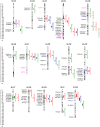Quantitative trait loci for yield and grain plumpness relative to maturity in three populations of barley (Hordeum vulgare L.) grown in a low rain-fall environment
- PMID: 28542571
- PMCID: PMC5441627
- DOI: 10.1371/journal.pone.0178111
Quantitative trait loci for yield and grain plumpness relative to maturity in three populations of barley (Hordeum vulgare L.) grown in a low rain-fall environment
Abstract
Identifying yield and grain plumpness QTL that are independent of developmental variation or phenology is of paramount importance for developing widely adapted and stable varieties through the application of marker assisted selection. The current study was designed to dissect the genetic basis of yield performance and grain plumpness in southern Australia using three doubled haploid (DH) populations developed from crosses between adapted parents that are similar in maturity and overall plant development. Three interconnected genetic populations, Commander x Fleet (CF), Commander x WI4304 (CW), and Fleet x WI4304 (FW) developed from crossing of Australian elite barley genotypes, were used to map QTL controlling yield and grain plumpness. QTL for grain plumpness and yield were analysed using genetic linkage maps made of genotyping-by-sequencing markers and major phenology genes, and field trials at three drought prone environments for two growing seasons. Seventeen QTL were detected for grain plumpness. Eighteen yield QTL explaining from 1.2% to 25.0% of the phenotypic variation were found across populations and environments. Significant QTL x environment interaction was observed for all grain plumpness and yield QTL, except QPlum.FW-4H.1 and QYld.FW-2H.1. Unlike previous yield QTL studies in barley, none of the major developmental genes, including Ppd-H1, Vrn-H1, Vrn-H2 and Vrn-H3, that drive barley adaption significantly affected grain plumpness and yield here. Twenty-two QTL controlled yield or grain plumpness independently of known maturity QTL or genes. Adjustment for maturity effects through co-variance analysis had no major effect on these yield QTL indicating that they control yield per se.
Conflict of interest statement
Figures
Similar articles
-
Genetic analysis of developmental and adaptive traits in three doubled haploid populations of barley (Hordeum vulgare L.).Theor Appl Genet. 2016 Jun;129(6):1139-51. doi: 10.1007/s00122-016-2689-z. Epub 2016 Feb 23. Theor Appl Genet. 2016. PMID: 26908251
-
Association of barley photoperiod and vernalization genes with QTLs for flowering time and agronomic traits in a BC2DH population and a set of wild barley introgression lines.Theor Appl Genet. 2010 May;120(8):1559-74. doi: 10.1007/s00122-010-1276-y. Epub 2010 Feb 13. Theor Appl Genet. 2010. PMID: 20155245 Free PMC article.
-
Assessment of genetic diversity and yield performance in Jordanian barley (Hordeum vulgare L.) landraces grown under Rainfed conditions.BMC Plant Biol. 2017 Nov 2;17(1):191. doi: 10.1186/s12870-017-1140-1. BMC Plant Biol. 2017. PMID: 29096621 Free PMC article.
-
Quantitative trait loci for water-use efficiency in barley (Hordeum vulgare L.) measured by carbon isotope discrimination under rain-fed conditions on the Canadian Prairies.Theor Appl Genet. 2012 Jun;125(1):71-90. doi: 10.1007/s00122-012-1817-7. Epub 2012 Feb 15. Theor Appl Genet. 2012. PMID: 22350092
-
Genetic Localization and Homologous Genes Mining for Barley Grain Size.Int J Mol Sci. 2023 Mar 3;24(5):4932. doi: 10.3390/ijms24054932. Int J Mol Sci. 2023. PMID: 36902360 Free PMC article. Review.
Cited by
-
Genotyping by Sequencing Advancements in Barley.Front Plant Sci. 2022 Aug 8;13:931423. doi: 10.3389/fpls.2022.931423. eCollection 2022. Front Plant Sci. 2022. PMID: 36003814 Free PMC article. Review.
-
Targeted enrichment by solution-based hybrid capture to identify genetic sequence variants in barley.Sci Data. 2019 Apr 1;6(1):12. doi: 10.1038/s41597-019-0011-z. Sci Data. 2019. PMID: 30931948 Free PMC article.
-
The Winter-Type Allele of HvCEN Is Associated With Earliness Without Severe Yield Penalty in Icelandic Spring Barley (Hordeum vulgare L.).Front Plant Sci. 2021 Sep 24;12:720238. doi: 10.3389/fpls.2021.720238. eCollection 2021. Front Plant Sci. 2021. PMID: 34630467 Free PMC article.
References
-
- ABARES. Agricultural Commodities, Australia, 2012–2013. 2014.
-
- FAOSTAT. Food and Agriculture Organization of the United Nations Statistics Division portal. 2014.
-
- Tester M, Langridge P. Breeding technologies to Increase crop production in a changing world. Science. 2010;327 - PubMed
-
- GTA. GTA Barley Standards 2014.
-
- Burger W, LaBerge D. Malting and Brewing Quality. In: Rasmusson DC, editor. Barley. Madison, WI 53711 USA: American Society of Agronomy; 1985. p. 367–401.
MeSH terms
Substances
LinkOut - more resources
Full Text Sources
Other Literature Sources


